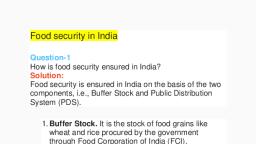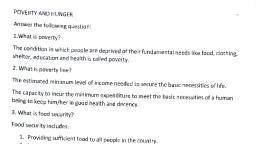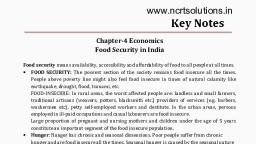Page 1 :
Food security in India, Question-1, How is food security ensured in India?, Solution:, Food security is ensured in India on the basis of the two, components, i.e., Buffer Stock and Public Distribution, System (PDS)., 1. Buffer Stock. It is the stock of food grains like, wheat and rice procured by the government, through Food Corporation of India (FCI)., 2. Public Distribution System. The food procured by, the FCI is distributed through government, regulated ration shops called Fair Price Shops, (FPS) among the poorer sections of the society., Question-2, Which are the people more prone to food insecurity?, Solution:, Although a large section of people suffers from food and, nutrition insecurity in India, the worst affected groups are, landless or land-poor households in rural areas and, people employed in ill-paid occupations and casual, labourers engaged in seasonal activities in the urban, areas., Question-5, A section of people in India is still without food. Explain?
Page 2 :
Solution:, Despite achieving self-sufficiency in food grains, as a, result of the Green Revolution, a section of people in, India are still without food because of poverty. Thus, the, landless labourers, casual urban workers, SCs, and STs, who are below the poverty line find it impossible to get, two square meals a day., The Public Distribution System is not functioning properly, because the ration shop owners are diverting the grains, to the open market. Low-quality grains are available at, ration shops which often remain unsold., Corruption in the Public Distribution System and extreme, poverty are the two basic reasons of why some people, are still without food in India., Question-6, What happens to the supply of food when there is a, disaster or a calamity?, Solution:, The poorest section of the society might be food, insecure most of the times while persons above the, poverty line might also be food insecure when the, country faces a national disaster/calamity like, earthquake, drought, flood, tsunami, widespread failure, of crops causing famine, etc., Question-7, Differentiate between seasonal hunger and chronic
Page 3 :
hunger?, Solution:, Seasonal hunger is related to cycles of food growing and, harvesting whereas chronic hunger is a consequence of, diets persistently inadequate in terms of quantity or, quality., People suffer from seasonal hunger in rural areas, because of the seasonal nature of agricultural activities, and because of causal labour in the urban areas, whereas poor people suffer from chronic hunger, because of very low income and thereby inability to buy, food even for bare survival., Question-8, What has our government done to provide food security, to the poor? Discuss any two schemes launched by the, government?, Solution:, In order to help the poor, and provide food security to, them,two special schemes were launched in 2000. They, were, Antyodaya Anna Yojana (AAY) and the Annapurna, Scheme (APS) with special target groups of ‘poorest of, the poor’ and ‘indigent senior citizens’, respectively. The, functioning of these two schemes was linked with the, existing network., Question-9, Why is a buffer stock created by the government?
Page 4 :
Solution:, To ensure availability of food to all sections of the society, the Indian government carefully designed a food security, system, which is composed of two components: (a), buffer stock and (b) public distribution system. This is, done to distribute foodgrains in the deficit areas and, among the poorer strata of society at a price lower than, the market price., Question-10, Write notes on Minimum Support Price, Buffer Stock,, Issue Price and Fair Price Shops., Solution:, a. Minimum Support Price, The farmers are paid a pre-announced price for their, crops. This price is called Minimum Support Price. The, MSP is declared by the government every year before, the sowing season to provide incentives to the farmers, for raising the production of these crops., b. Buffer Stock, Buffer Stock is the stock of food grains, namely wheat, and rice procured by the government through Food, Corporation of India (FCI)., c.Issue Price, Buffer stock is created to distribute food grains in the, deficit areas and among the poorer strata of society at a, price lower than the market price also known as Issue
Page 5 :
Price. This also helps resolve the problem of shortage of, food during adverse weather conditions or during periods, of calamity., d. Fair Price Shops, The food procured by the FCI is distributed through, government-regulated ration shops among the poorer, section of the society. This is called the public, distribution system (PDS). Ration shops are now present, in most localities, villages, towns and cities. There are, about 4.6 lakh ration shops all over the country. Ration, shops also known as Fair Price Shops keep stock of, food grains, sugar, kerosene oil for cooking. These items, are sold to people at a price lower.
















































